Banking customers are more diverse, complex, and demanding than ever. As a result, banks have to work harder to win their loyalty, with 75% saying they would switch to a bank that better fits their needs.
The problem is banking customers’ demands are increasingly varied amid economic uncertainties, increased competition, and generational shifts.
If banks want to retain their customers, they can’t treat them all the same. They need a bank customer segmentation strategy that allows them to reach specific customer groups and cater to their unique demands.
What is customer segmentation?
Customer segmentation divides a customer base into distinct groups based on shared characteristics or behaviours.
This allows companies to analyse the behaviours and needs of different customer groups. Banks can use these insights to target segments with relevant marketing throughout the customer cycle, e.g., new customers, inactive customers, loyal customers, etc.
You combine data points from multiple segmentation categories to create a customer segment. The most common customer segmentation categories include:
- Demographic segmentation
- Website activity segmentation
- Geographic segmentation
- Purchase history segmentation
- Product-based segmentation
- Customer lifecycle segmentation
- Technographic segmentation
- Channel preference segmentation
- Value-based segmentation
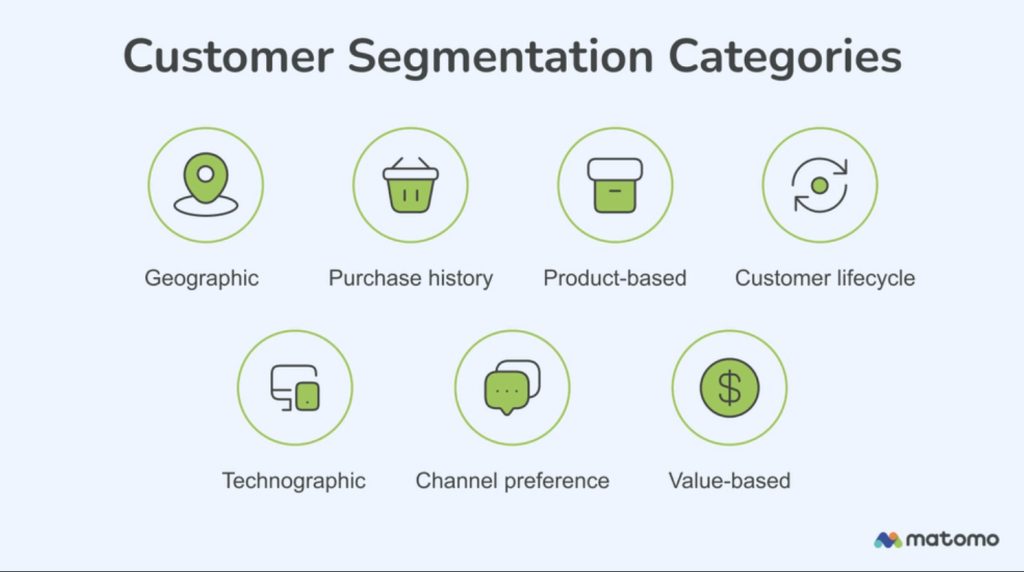
By combining segmentation categories, you can create detailed customer segments. For example, high-value customers based in a particular market, using a specific product, and approaching the end of the lifecycle. This segment is ideal for customer retention campaigns, localised for their market and personalised to satisfy their needs.
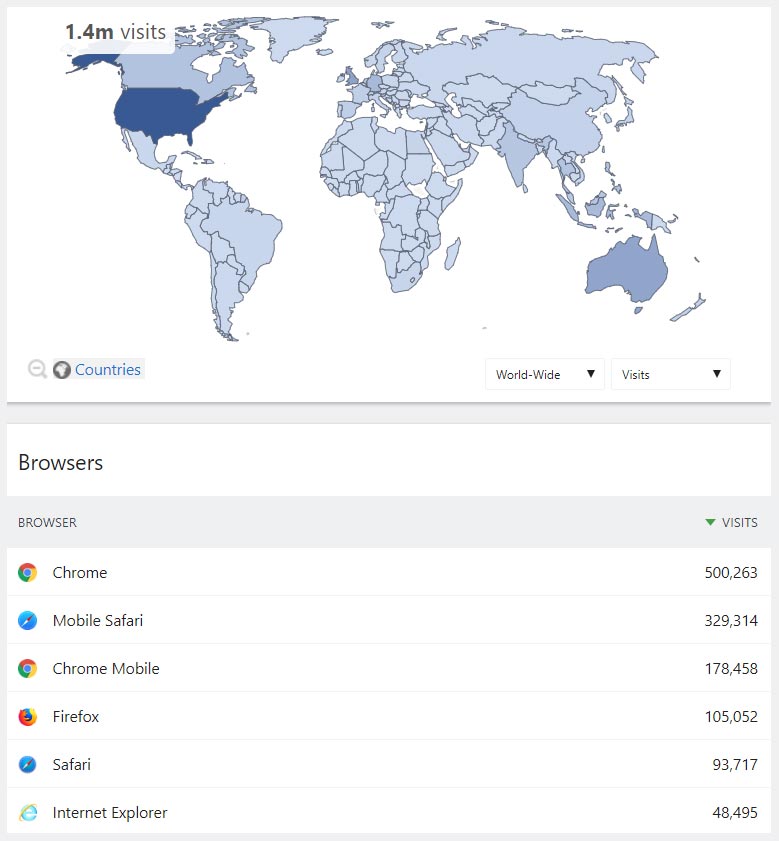
Matomo’s privacy-centric web analytics solution helps you capture data from the first visit. Unlike Google Analytics, Matomo doesn’t use data sampling (more on this later) or AI to fill in data gaps. You get 100% accurate data for reliable insights and customer segmentation.
Try Matomo for Free
Get the web insights you need, without compromising data accuracy.
Why is customer segmentation important for banks?
Customer segmentation allows you to address the needs of specific groups instead of treating all of your customers the same. This has never been more important amid a surge in bank switching, with three in four customers ready to switch to a provider that better suits their needs.
Younger customers are the most likely to switch, with 19% of 18-24 year olds changing their primary bank in the past year (PDF).
Customer expectations are changing, driven by economic uncertainties, declining trust in traditional banking, and the rise of fintech. Even as economic pressures lift, banks need to catch up with the demands of maturing millennials, Gen Z, and future generations of banking customers.
Switching is the new normal, especially for tech-savvy customers encouraged by an expanding world of digital banking options.
To retain customers, banks need to know them better and understand how their needs change over time. Customer retention provides the insights banks need to understand these needs at a granular level and the means to target specific customer groups with relevant messages.
At its core, customer segmentation is essential to banks for two key reasons:
- Customer retention: Holding on to customers for longer by satisfying their personal needs.
- Customer lifetime value: Maximising ongoing customer revenue through retention, purchase frequency, cross-selling, and upselling.
Here are some actionable bank customer segmentation strategies that can achieve these two objectives:
Prevent switching with segment analysis
Use customer segmentation to prevent them from switching to rivals by knowing what they want from you. Analyse customer needs and how they change throughout the lifecycle. Third-party data reveals general trends, but what do your customers want?
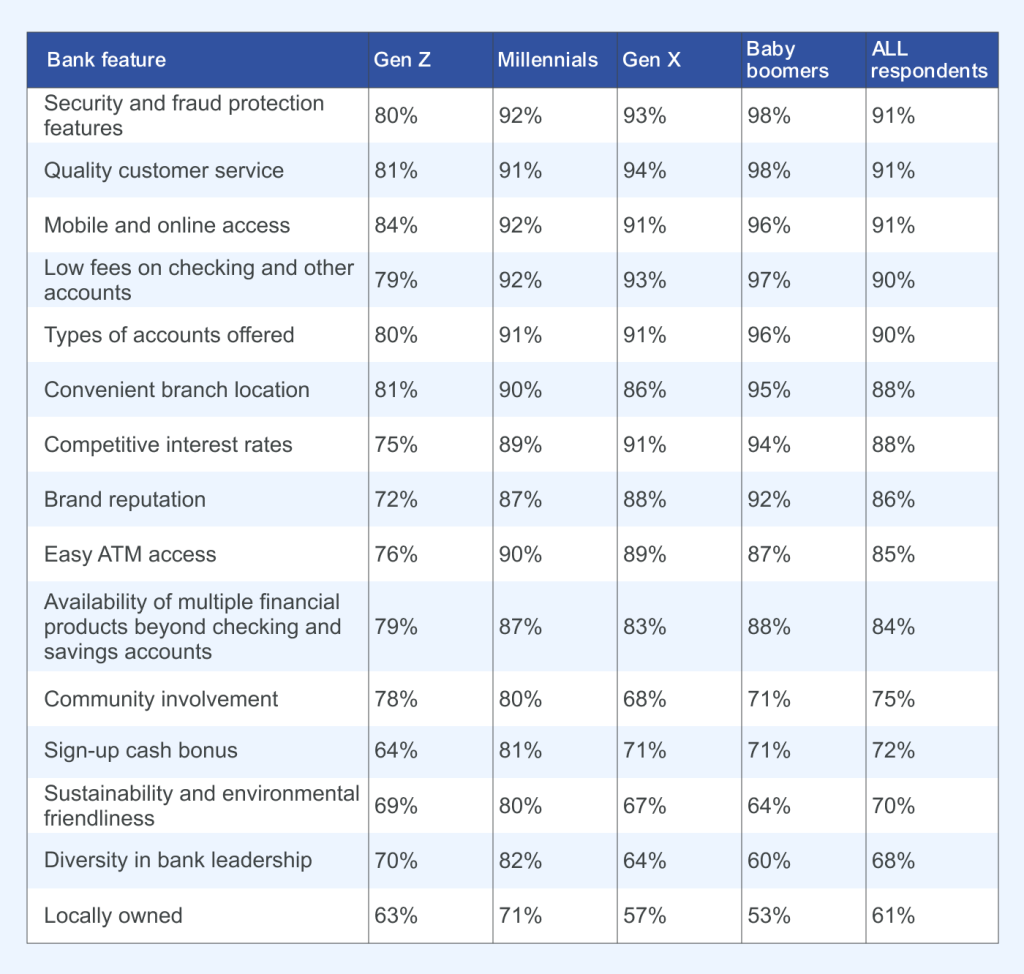
Use first-party customer data and segmentation to go beyond industry trends. Know exactly what your customers want from you and how to deliver targeted messages to each segment — e.g., first-time homebuyers vs. retirement planners.
Keep customers active with segment targeting
Target customer segments to keep customers engaged and motivated. Create ultra-relevant marketing messages and deliver them with precision to distinct customer segments. Nurture customer motivation by continuing to address their problems and aspirations.
Improve the quality of services and products
Knowing your customers’ needs in greater detail allows you to adapt your products and messages to cater to the most important segments. Customers switch banks because they feel their needs are better met elsewhere. Prevent this by implementing customer segmentation insights into product development and marketing.
Personalise customer experiences by layering segments
Layer segments to create ultra-specific target customer groups for personalised services and marketing campaigns. For example, top-spending customers are one of your most important segments, but there’s only so much you can do with this. However, you can divide this group into even narrower target audiences by layering multiple segments.
For example, segmenting top-spending customers by product type can create more relevant messaging. You can also segment recent activity and pinpoint specific usage segments, such as those with a recent drop in transactions.
Now, you have a three-layered segment of high-spending customers who use specific products less often and whom you can target with re-engagement campaigns.
Maximise customer lifetime value
Bringing all of this together, customer segmentation helps you maximise customer lifetime value in several ways:
- Prevent switching
- Enhance engagement and motivation
- Re-engage customers
- Cross-selling, upselling
- Personalised customer loyalty incentives
The longer you retain customers, the more you can learn about them, and the more effective your lifetime value campaigns will be.
Balancing bank customer segmentation with privacy and marketing regulations
Of course, customer segmentation uses a lot of data, which raises important legal and ethical questions. First, you need to comply with data and privacy regulations, such as GDPR and CCPA. Second, you also have to consider the privacy expectations of your customers, who are increasingly aware of privacy issues and rising security threats targeting financial service providers.
If you aim to retain and maximise customer value, respecting their privacy and protecting their data are non-negotiables.
Regulators are clamping down on finance
Regulatory scrutiny towards the finance industry is intensifying, largely driven by the rise of fintech and the growing threat of cyber attacks. Not only was 2023 a record-breaking year for finance security breaches but several compromises of major US providers “exposed shortcomings in the current supervisory framework and have put considerable public pressure on banking authorities to reevaluate their supervisory and examination programs” (Deloitte).
Banks face some of the strictest consumer protections and marketing regulations, but the digital age creates new threats.
In 2022, the Consumer Financial Protection Bureau (CFPB) warned that digital marketers must comply with finance consumer protections when targeting audiences. CFPB Director Rohit Chopra said: “When Big Tech firms use sophisticated behavioural targeting techniques to market financial products, they must adhere to federal consumer financial protection laws.”
This couldn’t be more relevant to customer segmentation and the tools banks use to conduct it.
Customer data in the hands of agencies and big tech
Banks should pay attention to the words of CFPB Director Rohit Chopra when partnering with marketing agencies and choosing analytics tools. Digital marketing agencies are rarely experts in financial regulations, and tech giants like Google don’t have the best track record for adhering to them.
Google is constantly in the EU courts over its data use. In 2022, the EU ruled that the previous version of Google Analytics violated EU privacy regulations. Google Analytics 4 was promptly released but didn’t resolve all the issues.
Meanwhile, any company that inadvertently misuses Google Analytics is legally responsible for its compliance with data regulations.
Banks need a privacy-centric alternative to Google Analytics
Google’s track record with data regulation compliance is a big issue, but it’s not the only one. Google Analytics uses data sampling, which Google defines as the “practice of analysing a subset of data to uncover meaningful information from a larger data set.”
This means Google Analytics places thresholds on how much of your data it analyses — anything after that is calculated assumptions. We’ve explained why this is such a problem before, and GA4 relies on data sampling even more than the previous version.
In short, banks should question whether they can trust Google with their customer data and whether they can trust Google Analytics to provide accurate data in the first place. And they do. 80% of financial marketers say they’re concerned about ad tech bias from major providers like Google and Meta.
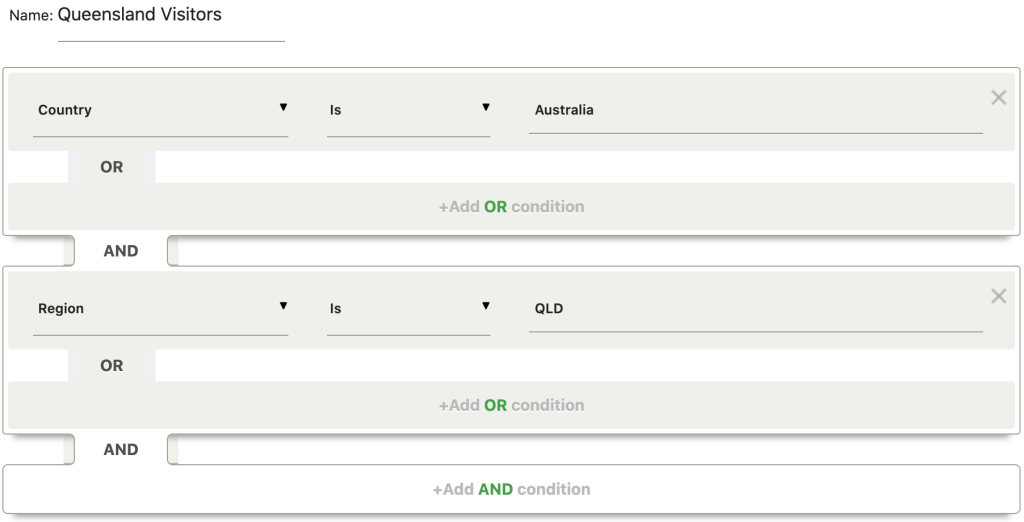
Matomo is the privacy-centric alternative to Google Analytics, giving you 100% data ownership and compliant web analytics. With no data sampling, Matomo provides 20-40% more data to help you make accurate, informed decisions. Get the data you need for customer segmentation without putting their data at risk.
Try Matomo for Free
Get the web insights you need, without compromising data accuracy.
Bank customer segmentation examples
Now, let’s look at some customer segments you create and layer to target specific customer groups.
Visit-based segmentation
Visit segmentation filters audiences based on the pages they visit on your website and the behaviors they exhibit—for example, first-time visitors vs. returning visitors or landing page visitors vs. blog page visitors.
If you look at HSBC’s website, you’ll see it is structured into several categories for key customer personas. One of its segments is international customers living in the US, so it has pages and resources expats, people working in the US, people studying in the US, etc.
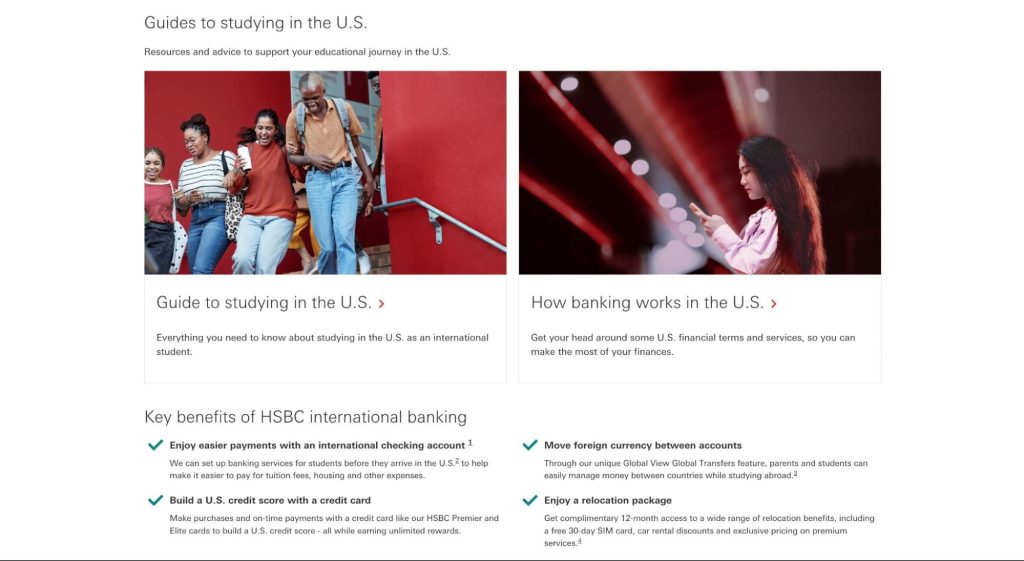
By combining visit-based segmentation with ultra-relevant pages for specific target audiences, HSBC can track each group’s demand and interest and analyse their behaviours. It can determine which audiences are returning, which products they want, and which messages convert them.
Demographic segmentation
Demographic segmentation divides customers by attributes such as age, gender, and location. However, you can also combine these insights with other non-personal data to better understand specific audiences.
For example, in Matomo, you can segment audiences based on the language of their browser, the country they’re visiting from, and other characteristics. So, in this case, HSBC could differentiate between visitors already residing in the US and those outside of the country looking for information on moving there.
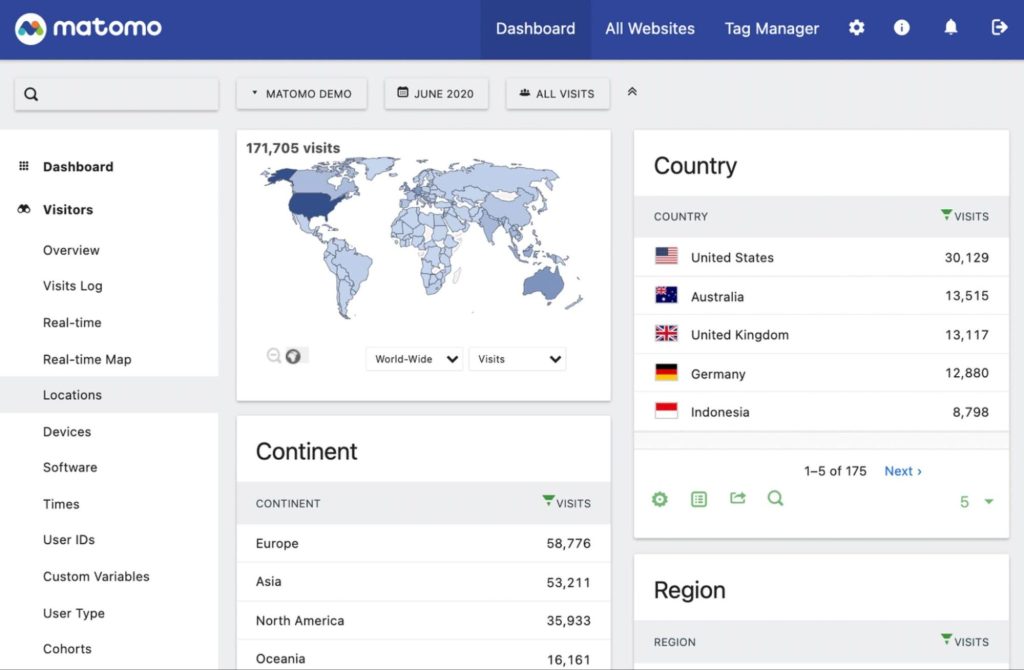
It could determine which countries they’re visiting, which languages to localise for, and which networks to run ultra-relevant social campaigns on.
Interaction-based segmentation
Interaction-based segmentation uses events and goals to segment users based on their actions on your website. For example, you can segment audiences who visit specific URLs, such as a loan application page, or those who don’t complete an action, such as failing to complete a form.

With events and goals set up, you can track the actions visitors complete before making purchases. You can monitor topical interests, page visits, content interactions, and pathways toward conversions, which feed into their customer journey.
From here, you can segment customers based on their path leading up to their first purchase, follow-up purchases, and other actions.
Purchase-based segmentation
Purchase-based segmentation allows you to analyse the customer behaviours related to their purchase history and spending habits. For example, you can track the journey of repeat customers or identify first-time buyers showing interest in other products/services.
You can implement these insights into your cross-selling and upselling campaigns with relevant messages designed to increase retention and customer lifetime value.
Get reliable website analytics for your bank customer segmentation needs
With customers switching in greater numbers, banks need to prioritise customer retention and lifetime value. Customer segmentation allows you to target specific customer groups and address their unique needs — the perfect strategy to stop them from moving to another provider.
Quality, accurate data is the key ingredient of an effective bank customer segmentation strategy. Don’t accept data sampling from Google Analytics or any other tool that limits the amount of your own data you can access. Choose a web analytics tool like Matamo that unlocks the full potential of your website analytics to get the most out of bank customer segmentation.
Matomo is trusted by over 1 million websites globally, including many banks, for its accuracy, compliance, and reliability. Discover why financial institutions rely on Matomo to meet their web analytics needs.
Start collecting the insights you need for granular, layered segmentation — without putting your bank customer data at risk. Request a demo of Matomo now.
.cloudsubform {
font-size: 13px;
}
.matomo_signup-elementor-widget .text-center {
text-align: center;
}
.cloudsubform label {
font-weight: bold;
}
.cloudsubform input {
width: 100%;
}
.cloudsubform .list-unstyled {
list-style:none;
margin-left: 0;
}
input.form-control {
border-color: #e7e7e7;
background: #fff;
}
.has-error .checkbox, .has-error .checkbox-inline, .has-error .control-label, .has-error .help-block, .has-error .radio, .has-error .radio-inline, .has-error.checkbox label, .has-error.checkbox-inline label, .has-error.radio label, .has-error.radio-inline label {
color: #a94442;
}
.has-error .form-control {
border-color: #a94442;
}
.form-group.has-error:focus-within .with-errors {
display: none;
}
.input-group {
position: relative;
display: table;
border-collapse: separate;
}
.input-group .form-control:first-child, .input-group-addon:first-child, .input-group-btn:first-child>.btn, .input-group-btn:first-child>.btn-group>.btn, .input-group-btn:first-child>.dropdown-toggle, .input-group-btn:last-child>.btn-group:not(:last-child)>.btn, .input-group-btn:last-child>.btn:not(:last-child):not(.dropdown-toggle) {
border-top-right-radius: 0;
border-bottom-right-radius: 0;
}
.input-group .form-control, .input-group-addon, .input-group-btn {
display: table-cell;
}
.input-group .form-control {
position: relative;
z-index: 2;
float: left;
width: 100%;
margin-bottom: 0;
}
.input-group-addon:last-child {
border-left: 0;
}
.input-group .form-control:last-child, .input-group-addon:last-child, .input-group-btn:first-child>.btn-group:not(:first-child)>.btn, .input-group-btn:first-child>.btn:not(:first-child), .input-group-btn:last-child>.btn, .input-group-btn:last-child>.btn-group>.btn, .input-group-btn:last-child>.dropdown-toggle {
border-top-left-radius: 0;
border-bottom-left-radius: 0;
}
.input-group-addon {
padding: 6px 12px;
font-size: 14px;
font-weight: 400;
line-height: 1;
color: #333;
text-align: center;
background-color: #f2f2f2;
border: 1px solid #e7e7e7;
border-radius: 4px;
}
.input-group-addon, .input-group-btn {
width: 1%;
white-space: nowrap;
vertical-align: middle;
}
.input-group .form-control, .input-group-addon, .input-group-btn {
display: table-cell;
}
.startTrialButton {
background: #299903;
}
.startTrialButton:hover {
background: #16bb0f;
}
.privacyNotice,
header.page-header .entry-summary {
color: #47525f;
margin-top: 15px;
}
header.page-header .page-title {
margin-bottom: 15px;
}
header.page-header {
margin-top: 20px;
margin-bottom: 20px;
}
h2.page-title {
font-size: 30px;
}
input::placeholder {
color: #aeaeae;
}
#signup_form input {
color: #333;
}
.privacyNotice, header.page-header .entry-summary, .form-group label, input {
font-family: Nunito, Arial, sans-serif;
}
.form-group label {
font-size: 14px;
cursor: pointer;
}
.form-group label.checkboxLabel {
font-weight: normal;
}
#signup_form .alert-danger,
.form-group .alert-danger {
color: #a94442;
}
.privacyNotice {
color: #818181;
font-size: 14px;
}
.cloudsubform input[disabled] {
background: #e7e7e7 !important;
}
Try Matomo for Free
21 day free trial. No credit card required.
